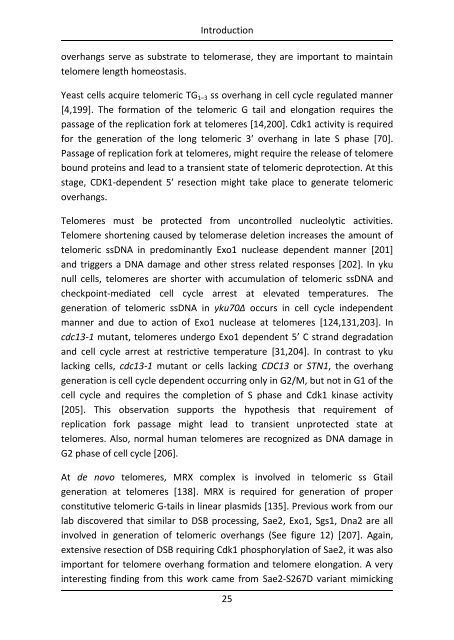View/Open - Università degli Studi di Milano-Bicocca
View/Open - Università degli Studi di Milano-Bicocca
View/Open - Università degli Studi di Milano-Bicocca
Create successful ePaper yourself
Turn your PDF publications into a flip-book with our unique Google optimized e-Paper software.
Introduction<br />
overhangs serve as substrate to telomerase, they are important to maintain<br />
telomere length homeostasis.<br />
Yeast cells acquire telomeric TG1–3 ss overhang in cell cycle regulated manner<br />
[4,199]. The formation of the telomeric G tail and elongation requires the<br />
passage of the replication fork at telomeres [14,200]. Cdk1 activity is required<br />
for the generation of the long telomeric 3′ overhang in late S phase [70].<br />
Passage of replication fork at telomeres, might require the release of telomere<br />
bound proteins and lead to a transient state of telomeric deprotection. At this<br />
stage, CDK1-dependent 5′ resection might take place to generate telomeric<br />
overhangs.<br />
Telomeres must be protected from uncontrolled nucleolytic activities.<br />
Telomere shortening caused by telomerase deletion increases the amount of<br />
telomeric ssDNA in predominantly Exo1 nuclease dependent manner [201]<br />
and triggers a DNA damage and other stress related responses [202]. In yku<br />
null cells, telomeres are shorter with accumulation of telomeric ssDNA and<br />
checkpoint-me<strong>di</strong>ated cell cycle arrest at elevated temperatures. The<br />
generation of telomeric ssDNA in yku70Δ occurs in cell cycle independent<br />
manner and due to action of Exo1 nuclease at telomeres [124,131,203]. In<br />
cdc13-1 mutant, telomeres undergo Exo1 dependent 5’ C strand degradation<br />
and cell cycle arrest at restrictive temperature [31,204]. In contrast to yku<br />
lacking cells, cdc13-1 mutant or cells lacking CDC13 or STN1, the overhang<br />
generation is cell cycle dependent occurring only in G2/M, but not in G1 of the<br />
cell cycle and requires the completion of S phase and Cdk1 kinase activity<br />
[205]. This observation supports the hypothesis that requirement of<br />
replication fork passage might lead to transient unprotected state at<br />
telomeres. Also, normal human telomeres are recognized as DNA damage in<br />
G2 phase of cell cycle [206].<br />
At de novo telomeres, MRX complex is involved in telomeric ss Gtail<br />
generation at telomeres [138]. MRX is required for generation of proper<br />
constitutive telomeric G-tails in linear plasmids [135]. Previous work from our<br />
lab <strong>di</strong>scovered that similar to DSB processing, Sae2, Exo1, Sgs1, Dna2 are all<br />
involved in generation of telomeric overhangs (See figure 12) [207]. Again,<br />
extensive resection of DSB requiring Cdk1 phosphorylation of Sae2, it was also<br />
important for telomere overhang formation and telomere elongation. A very<br />
interesting fin<strong>di</strong>ng from this work came from Sae2-S267D variant mimicking<br />
25

















